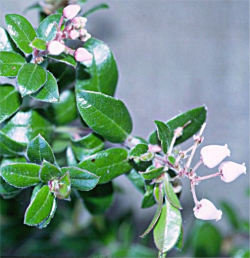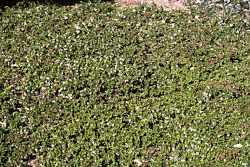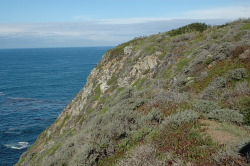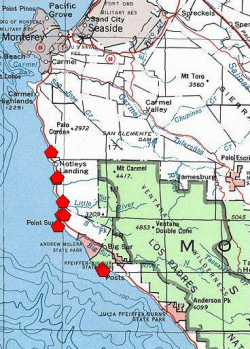
endangered

Photo taken at the UCSC Arboretum by Dean W. Taylor

Photo taken at the UCSC Arboretum by Dean W. Taylor

Habitat of A. edmundsii taken along the Big Sur coast, Monterey County by Dean W. Taylor

A red polygon indicates an extant occurrence



This fact sheet was prepared by Dylan M. Neubauer and Dean W. Taylor under award NA04N0S4200074 from the National Oceanic and Atmospheric Administration (NOAA), U.S. Department of Commerce (DOC). The statements, findings, conclusions, and recommendations are those of the authors and do not necessarily reflect the views of the NOAA or the DOC.
© Copyright 2006, Elkhorn Slough Coastal Training Program
Last updated: Sep 23, 2024 09:35
Common Names - Little Sur manzanita
Family - Ericaceae (Heath Family)
State Status - state rare
(var. parvifolia)
Federal Status - none
Habitat
Steep sandstone outcrops and sea bluffs along the Big Sur coast in low-growing scrub in sites with direct exposure to ocean winds; 10–105 m.
Key Characteristics
Prostrate to mounded shrubs, basal burl absent; twigs sparsely short-nonglandular-hairy; leaves spreading, petiole 2–3 mm, blade elliptic to round-ovate, 1–1.5 cm wide, dark green, shiny, base truncate to more-or-less lobed; inflorescence paniculate, 2–5 branched, bracts 3–5 mm long, scale-like; filament base pubescent; fruit spheric, glabrous (Parker et al. 2013). Arctostaphylos uva-ursi, also very rare in our region, is similar in general habit, but has leaves oblanceolate to obovate (occasionally narrowly elliptic), base wedge-shaped, and inflorescence racemose, 0–1-branched. Growth form variable owing to salt spray and wind effects.
Flowering Period
November to April
Reference Populations
Pt. Sur Coast Guard Station, Pfeiffer Beach State Park (Monterey County)
Global Distribution
Endemic to the Big Sur coast of California.
Conservation
Known from eight sites along the Big Sur coast from Garrapata Creek south to Pfeiffer Point. Three sites are on public lands and suffer from trampling and bluff and trail erosion. Forma parvifolia, with exceedingly reddish, small leaves, was considered by Wells (1988) to be only a minor variant, and is perhaps environmentally induced. This form (= A. e. var. parvifolia Roof) is state-listed as rare (CNPS 2014). Roof’s (1980) hypothesis that A. edmundsii is derived by stabilized hybridization between A. uva-ursi and A. tomentosa ssp. rosei has not been eliminated (Markos et al. 1998). Cultivars are available in the horticultural trade (‘Carmel Sur’ being the most common).
References
CNPS, Rare Plant Program. 2014. Arctostaphylos edmundsii, in Inventory of Rare and Endangered Plants (online edition, v8-02). California Native Plant Society, Sacramento, CA. http://www.rareplants.cnps.org/detail/25.html [accessed 1 February 2015].
Markos, S., L. C. Hileman, M. C. Vasey, and V. T. Parker. 1998. Phylogeny of the Arctostaphylos hookeri complex (Ericaceae) base on nrDNA data. Madroño 45(3):187–199.
Parker, V. T., M. C. Vasey, and J. E. Keeley. 2013. Arctostaphylos, in Jepson Flora Project (eds.). Jepson eFlora, http://ucjeps.berkeley.edu/cgi-bin/get_IJM.pl?tid=13923 [accessed 1 February 2015].
Roof, J. B. 1980. Changing Seasons 1(3):2–31
Wells, P. V. 1988. New combinations in Arctostaphylos: annotated list of changes in status. Madroño 35(4):330–341.
